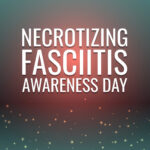Necrotizing Fasciitis Awareness Day is on May 31 and this day aims to provide information and help for the treatment and prevention of this infection. It also encourages people to provide support in any way possible for those affected with necrotizing fasciitis. This disease is caused by bacteria and can destroy the skin, fat, and tissue covering the muscles. If not treated properly and in time, it can spread rapidly and cause great harm.
History of Necrotizing Fasciitis Awareness Day
Necrotizing fasciitis is a rare bacterial disease, which infects the tissues of the skin and spreads rapidly. Unfortunately, every one out of four people who are affected by it can die from this infection. Until the 19th century, this disease was known as phagedenic ulcer, phagedena gangrenosa, gangrenous ulcer, malignant ulcer, putrid ulcer, or hospital gangrene.
In 2006, a man named Tim Hayden developed a scratch on his knuckle. One day, he woke up with flu-like symptoms and red streaks on his arms and torso. He was taken to a hospital immediately. An infectious disease specialist identified the symptoms as a sign of necrotizing fasciitis and prescribed emergency treatment including surgeries and physical therapy. In 2016, Hayden formed an online support group for survivors of necrotizing fasciitis. A year later, he launched a foundation and, since then, May 31 was established as Necrotizing Fasciitis Awareness Day. Governor Rick Snyder of Michigan declared Necrotizing Fasciitis Awareness Day in that same year, and many other states in the United States have followed suit since then. Thus Necrotizing Fasciitis Awareness Day has been observed each year for the last four years in the United States.
Necrotizing fasciitis is believed to be most commonly caused by group A Streptococcus. It is rare, especially in healthy people. However, that does not mean we should be lackadaisical when we get a small cut. Identifying the symptoms in time can literally help save your life.
Necrotizing Fasciitis Awareness Day timeline
Hippocrates first describes necrotizing soft tissue infection as a disease where you get erysipelas all over the body.
British surgeon Leonard Gillespie and British physicians Gilbert Blaine and Thomas Trotter give the first English definition for necrotizing soft-tissue infection.
Jean Alfred Fournier first describes necrotizing fasciitis in medical literature as a disease of unknown causes.
The term ‘necrotizing fasciitis’ is coined by Dr. B. Wilson.
Necrotizing Fasciitis Awareness Day FAQs
When should you suspect necrotizing fasciitis?
The signs and symptoms for necrotizing fasciitis severe pain, swelling, fever, the infected skin might show discoloration and feel tight. It is advisable to immediately seek medical help when you notice any symptoms.
How do you manage necrotizing fasciitis?
First and foremost, an antibiotics course is prescribed to help treat the infection. Additionally, the dead or infected tissue must be removed surgically to help the body recover from this disease.
How can you prevent necrotizing fasciitis?
Currently, there is no available vaccine for necrotizing fasciitis. However, you can do your bit in preventing the disease by maintaining good hygiene. Especially when you get cuts, wash them immediately and apply an antiseptic. Seek medical attention immediately if the cut worsens and you see uncommon symptoms.
How To Observe Necrotizing Fasciitis Awareness Day
Donate to a necrotizing fasciitis charity
Necrotizing fasciitis can be extremely taxing, not only physically, but also on one’s mental well-being, and can cause a financial burden as well. You can donate to a charity that aims to help affected victims financially.
Learn about necrotizing fasciitis
While this is a rare disease, its effects can be very harmful. It’s important to read up about necrotizing fasciitis and keep yourself and others around you aware. Having adequate knowledge about this disease will be of use when identifying the onset of this infection and seeking timely care.
Volunteer to help
People affected with necrotizing fasciitis require all the help they can get, be it mentally or physically, to fight this disease. However, you don’t necessarily have to help someone with the disease, if you don’t know of anyone affected by it. You can also volunteer to help the organizations that are spreading awareness about the disease.
5 Important Facts To Know About Necrotizing Fasciitis
Multiple types of bacteria
There is more than one type of common and rare bacteria that causes necrotizing fasciitis.
High-risk groups
Individuals with a weak immune system, unfortunately, belong to the high-risk group for necrotizing fasciitis.
High-tech treatment
High-tech treatment such as the usage of a hyperbaric oxygen chamber can help to prevent tissue damage.
Where it occurs
Necrotizing fasciitis most commonly occurs on the perineum, extremities, and genitals.
Number of annual cases
The Center for Disease Control states that each year in the United States there are an estimated 9,000-11,500 people with group A streptococcus bacterial infections, one of the causes of necrotizing fasciitis.
Why Necrotizing Fasciitis Awareness Day Is Important
It’s a rare and serious disease
Necrotizing fasciitis is a rare and serious disease caused by a bacterial infection. It can spread quickly if it’s not diagnosed and treated in time. Delaying treatment can also hamper the chances of recovery. Thus Necrotizing Fasciitis Awareness Day is important to educate as many people about it as possible.
Necrotizing fasciitis can be prevented
Necrotizing fasciitis is extremely rare and can be prevented if treated in time. When you get a cut, even if it's a minor one, it’s important to treat it instantly to prevent any bacteria from entering. As they say, prevention is better than cure.
It aids in collecting resources for affected people
Treatment for necrotizing fasciitis can be costly as it involves surgery. This day can help to inform others about the disease and collect any monetary help that can be used to treat affected patients.
Necrotizing Fasciitis Awareness Day dates
| Year | Date | Day |
|---|---|---|
| 2026 | May 31 | Sunday |
| 2027 | May 31 | Monday |
| 2028 | May 31 | Wednesday |
| 2029 | May 31 | Thursday |
| 2030 | May 31 | Friday |

















